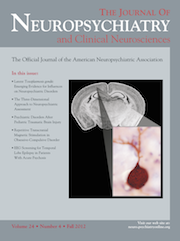Cabergoline-Induced Psychosis in a Patient With Undiagnosed Depression
To the Editor: Dopamine agonists bromocriptine and cabergoline are used in the medical treatment of prolactinomas.1 Emergence of psychotic symptoms is a more established association with bromocriptine treatment.2 With cabergoline it is reported once, and only in patients with known paranoid schizophrenia.3 Like other pro-dopaminergic agents, its potential to cause psychosis in patients with no history of psychosis is theoretically there, but not reported. The following is a case of cabergoline-induced psychosis in a woman with no prior psychiatric history of psychosis, who was being treated for a prolactinoma.
A 44-year-old woman became convinced she was in an episode of the TV show “Hoarders.” She thought she saw a film crew from her apartment window and somehow inferred they wanted to harm her. She called 911 when she thought they infiltrated her apartment. When the police came, they took her to the psychiatric emergency room, not having found any evidence of people inside her apartment. Delusions and visual hallucinations had developed 1 week before admission. In the psychiatric unit, a detailed history uncovered that she had been being treated for a prolactinoma with cabergoline for 3 months. Before cabergoline, the patient was treated with bromocriptine, but this was changed because of complaints of lethargy.
Cabergoline was stopped, and, without need to give an antipsychotic, all symptoms revolved within 48 hours of observation in the hospital. Review of psychiatric symptoms after resolution of psychosis uncovered some sadness, poor energy, passive suicidal thoughts, free-floating anxiety, excessive alcohol use, and a history of compulsive hoarding, with some frequent hand-washing, but no noted obsessions or other compulsions. Stressors included unemployment, social isolation, and breaking up with boyfriend of many years. She remembered feeling depressed for many years and not seeking any psychiatric treatment. She has a family history of attempted suicide in her father and completed suicide in an uncle. She accepted a referral to an intensive outpatient program and deferred starting any further treatment to that setting. The patient’s progress was monitored over 1 month after hospital discharge, and no symptoms of psychosis were noted.
To our knowledge, this is the first reported case of cabergoline-induced psychosis in a patient with no previous history of psychosis. Our patient reported a history of long-standing untreated depression, compulsive hoarding, self-medicating with alcohol, and many psychosocial stressors. We wondered if patients with severe depression, in particular, constituted a clinical population who warrant careful monitoring when they are prescribed caberogoline because of fear of inducing psychosis. This, we feel, is a potentially important clinical situation that deserves further study.
1 : Management of psychosis associated with a prolactinoma: case report and review of the literature. Psychosomatics 2010; 51:370–376Crossref, Medline, Google Scholar
2 : Bromocriptine and psychosis: a literature review. Psychiatr Q 1995; 66:87–95Crossref, Medline, Google Scholar
3 : Cabergoline-induced psychotic exacerbation in schizophrenic patients. Gen Hosp Psychiatry 2008; 30:378–380Crossref, Medline, Google Scholar



